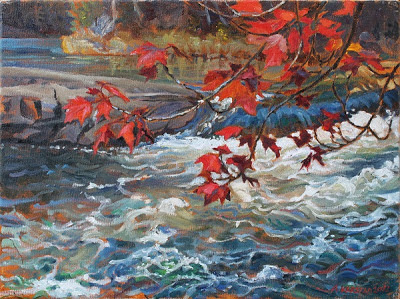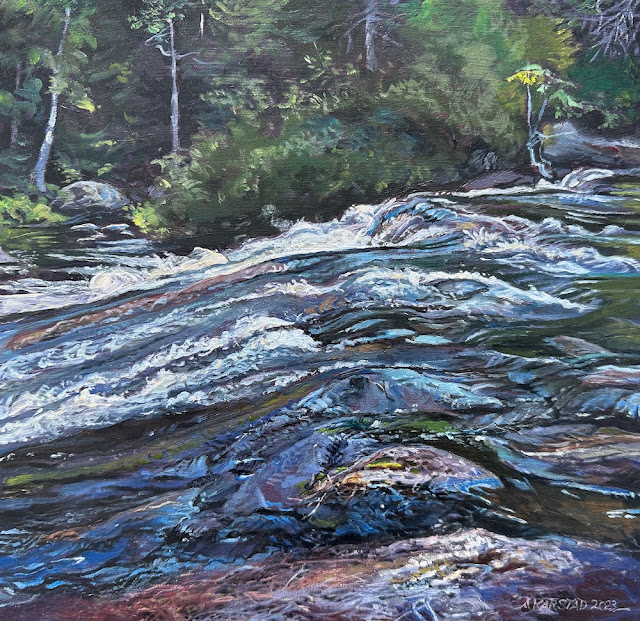Sturgeon Chute, Upper Rapids (oil on canvas, 12 x 16 in.) Sold
1 October finds me painting at the upstream rapids of Sturgeon Chute on the Wanapite River, 6.7 kilometres northwest of Hartley Bay. To get just the right angle on the rapids, screened by flaming leaves of an overhanging Red Maple, I'm standing on a narrow grassy ledge, the small of my back leaning against a cold wall of smooth granite, with the feet of my easel only a few centimetres from the edge. About two metres below, courses the fast deep water,
dark in the shadow of the
steep forested wall of the chute. From here I am looking upstream toward the border of the French River Provincial Park. As I scratch my composition into a fresh rich ochre underpainting, the intensely blue sky is beginning to be tufted by little cumulus fragments. The water rolls over a ledge that extends from the rock across the river. It's nearly black where wet and then darkish grey in a band to 70 cm above current water level - grading to reddish above, which may be the native colour of the rock.
dark in the shadow of the
steep forested wall of the chute. From here I am looking upstream toward the border of the French River Provincial Park. As I scratch my composition into a fresh rich ochre underpainting, the intensely blue sky is beginning to be tufted by little cumulus fragments. The water rolls over a ledge that extends from the rock across the river. It's nearly black where wet and then darkish grey in a band to 70 cm above current water level - grading to reddish above, which may be the native colour of the rock.
As I arrange my mug of water and brushes in a crack with little Goldenrod, and my palette on a rubber mat on the rock that slopes down toward the water on my right, Fred walks past on the trail through the woods above my painting spot, heading for where the shore is low and grassy beyond these rapids. He will check for clams where the bank is clay. A little later, Jim Rook follows him with our dog Marigold and his Airedale Tucker. Jim brought us by boat right up to the falls at the mouth of Sturgeon Chute, and we traced the rapids on the portage trail to this point, which is near where the hydroelectric dam is planned to span the river - across this rapids, an island, and the rapids on the other side. Jim told us that the water is the highest it's been since May - partly due to releases from dams upstream.
With every puff of breeze, Maple leaves let go and clatter down, and clusters of yellow needles sprinkle on me from the White Pines above me. The rock is smooth and gneiss-like with a big vein of white quartz under my painting box. The rock is hoary with grey crustose lichens, patchy with paler crustose and foliose growths, and spotted with rounds of bright green Parmelia lichen. Puffs of Cladonia Reindeer Moss, and a network of lines of black moss in the cracks.In the smaller cracks where there's Vaccinium, Vetch, Yarrow, Goldenrod, and Grasses. Purpling Ninebark and a small gone-to-yellow Thalictrum grow in a bigger crack.
Fred returns with Pyganodon grandis (Common Floater) shells that he'd found in a huge shell pile in the steep clay shore, where there were lots of Beaver paths and debarked sticks. His sample includes 51 pairs, 28 broken pairs, 36 left valves 48 right valves (adding 65 to the count by the rule of 1.5), and a pile of fragments (not counted). The largest 104 mm. If this sample was 20% of the entire pile, then the pile comprised more than 700 shells.
These shells are fabulously variable in shape, from ordinary shapes to compressed like Elliptio complanata (Eastern Elliptio) to big-beaked inflated like Alasmidonta marginata (Elktoe) to more cylindrical than Anodontoides ferussacianus (Cylindrical Floater). He later found one Elliptio shell.
I have most of the painting finished by the time we'd set for leaving. Jim is concerned about visibility of the many deadhead logs that poke their ends barely above the river's surface. If the light is low, or the water ruffled by wind, seeing these logs to avoid hitting them with the boat's propeller, is difficult. On our way up the winding, clay-shored Wanapite from Hartley Bay, we saw several Map Turtles basking on these deadheads.
Later: We missed all the deadheads on the way back. Most of the turtles had left their sunning spots, but there was still some excitement as we watched a medium-sized Black Bear swim across the river about 30 metres ahead of us. As it emerged it didn't bother to pause and shake its streaming coat, but just disappeared among the tall riverbank grasses. As we passed the spot we saw a dark opening in the vegetation at that spot. He'd been swimming straight for the trail.
These shells are fabulously variable in shape, from ordinary shapes to compressed like Elliptio complanata (Eastern Elliptio) to big-beaked inflated like Alasmidonta marginata (Elktoe) to more cylindrical than Anodontoides ferussacianus (Cylindrical Floater). He later found one Elliptio shell.
I have most of the painting finished by the time we'd set for leaving. Jim is concerned about visibility of the many deadhead logs that poke their ends barely above the river's surface. If the light is low, or the water ruffled by wind, seeing these logs to avoid hitting them with the boat's propeller, is difficult. On our way up the winding, clay-shored Wanapite from Hartley Bay, we saw several Map Turtles basking on these deadheads.
Later: We missed all the deadheads on the way back. Most of the turtles had left their sunning spots, but there was still some excitement as we watched a medium-sized Black Bear swim across the river about 30 metres ahead of us. As it emerged it didn't bother to pause and shake its streaming coat, but just disappeared among the tall riverbank grasses. As we passed the spot we saw a dark opening in the vegetation at that spot. He'd been swimming straight for the trail.
Dear patrons and supporters,
This painting, in my current series, "Waterfalls Rapids and Dams" is for sale by auction to support our work with the Ontario Rivers Alliance as we visit and study more rivers at risk. If you would like to purchase it, please send your bid to me Bidding is open for one week from posting date, ending on 16 October at 4:00 pm eastern daylight time. The starting price is $450.
Aleta




Comments
Post a Comment
What do you think of this painting, and what do you know about the subject that I have painted?